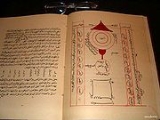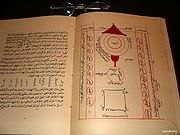
Muhammad Ghawth
Encyclopedia
Muhammad Ghawth Gwaliyari was a 16th century Sufi
master of the Shattari
order and Sufi saint, a musician, and the author of Jawahir-i Khams (Arabic: al-Jawahir al-Khams, meaning the Five Jewels).
, son of Muhammad al-Baqir
, son of Zayn al-Abidin, son of Husain ibn Ali, son of Ali ibn Abi Talib.
He was born probably in 906 AH
(1500 CE
)
In the preface of al-Jawahir al-Khams, he states that he wrote the book when he was 25 years old. In 956 A.H. (1549 CE) he travelled to Gujarat, when he was 50 years old.
Among Ghawth's disciples is Fazl Allah Shattari (also known as Shah Fazl Shattari), who wrote a biography or monograph in praise of his teacher. Gwawth taught the Mughal Emperor
Humayun
, and was also a tutor of the Mughal Emperor Akbar's favorite musician, Tansen
. It is uncertain whether Tansen was tutored in Sufism, in music or in both, but Tansen was familiar with Sufism.
Badusha, Abdul Qadir, Shahul Hamid Ganjasavoy of nagore Tamil Nadu is also one his important disciple.
Muhammad Ghawth died in 1562 CE. Ghawth's tomb, in Gwalior (a city in Madhya Pradesh
in India
), which was built in his honour by Akbar, is a well-known tourist attraction and regarded as an excellent example of Mughal Architecture
. Tansen was buried in Ghawth's tomb complex.

Sufism
Sufism or ' is defined by its adherents as the inner, mystical dimension of Islam. A practitioner of this tradition is generally known as a '...
master of the Shattari
Shattari
The Shattariyya are members of a Sufi mystical order that originated in Persia in the fifteenth century C.E. and formally developed, completed and codified in India. Later secondary branches were taken to Hejaz and Indonesia...
order and Sufi saint, a musician, and the author of Jawahir-i Khams (Arabic: al-Jawahir al-Khams, meaning the Five Jewels).
Biography
Muhammad Ghawth Gwaliyari was a son of Sayyid Hazir al-Din (misspelled Khatir al-Din) Bayazid, son of Khawajah Farid al-Attar, son of Sima Wasil, son of Ahmad al-Sadiq, son of Najibuddin Taqiyuddin, son of Nur Allah Abu Bakr al-Ajli, son of Isma'il ibn Jafar, son of Ja'far al-SadiqJa'far al-Sadiq
Jaʿfar ibn Muhammad al-Sādiq was a descendant of Muhammad and a prominent Muslim jurist. He is revered as an Imam by the adherents of Shi'a Islam and as a renowned Islamic scholar and personality by Sunni Muslims. The Shi'a Muslims consider him to be the sixth Imam or leader and spiritual...
, son of Muhammad al-Baqir
Muhammad al-Baqir
Muḥammad ibn ‘Alī al-Bāqir was the Fifth Imām to the Twelver Shi‘a and Fourth Imām to the Ismā‘īlī Shī‘a. His father was the previous Imām, ‘Alī ibn Ḥusayn, and his mother was Fatimah bint al-Hasan...
, son of Zayn al-Abidin, son of Husain ibn Ali, son of Ali ibn Abi Talib.
He was born probably in 906 AH
Islamic calendar
The Hijri calendar , also known as the Muslim calendar or Islamic calendar , is a lunar calendar consisting of 12 lunar months in a year of 354 or 355 days. It is used to date events in many Muslim countries , and used by Muslims everywhere to determine the proper day on which to celebrate Islamic...
(1500 CE
Common Era
Common Era ,abbreviated as CE, is an alternative designation for the calendar era originally introduced by Dionysius Exiguus in the 6th century, traditionally identified with Anno Domini .Dates before the year 1 CE are indicated by the usage of BCE, short for Before the Common Era Common Era...
)
In the preface of al-Jawahir al-Khams, he states that he wrote the book when he was 25 years old. In 956 A.H. (1549 CE) he travelled to Gujarat, when he was 50 years old.
Among Ghawth's disciples is Fazl Allah Shattari (also known as Shah Fazl Shattari), who wrote a biography or monograph in praise of his teacher. Gwawth taught the Mughal Emperor
Mughal Empire
The Mughal Empire , or Mogul Empire in traditional English usage, was an imperial power from the Indian Subcontinent. The Mughal emperors were descendants of the Timurids...
Humayun
Humayun
Nasir ud-din Muhammad Humayun was the second Mughal Emperor who ruled present day Afghanistan, Pakistan, and parts of northern India from 1530–1540 and again from 1555–1556. Like his father, Babur, he lost his kingdom early, but with Persian aid, he eventually regained an even larger one...
, and was also a tutor of the Mughal Emperor Akbar's favorite musician, Tansen
Tansen
Mia Tansen is considered among the greatest composer-musicians in Hindustani classical music. He was an extraordinarily gifted vocalist, known for a large number of compositions, and also an instrumentalist who popularized and improved the rabab .He was among the Navaratnas at the court of the...
. It is uncertain whether Tansen was tutored in Sufism, in music or in both, but Tansen was familiar with Sufism.
Badusha, Abdul Qadir, Shahul Hamid Ganjasavoy of nagore Tamil Nadu is also one his important disciple.
Muhammad Ghawth died in 1562 CE. Ghawth's tomb, in Gwalior (a city in Madhya Pradesh
Madhya Pradesh
Madhya Pradesh , often called the Heart of India, is a state in central India. Its capital is Bhopal and Indore is the largest city....
in India
India
India , officially the Republic of India , is a country in South Asia. It is the seventh-largest country by geographical area, the second-most populous country with over 1.2 billion people, and the most populous democracy in the world...
), which was built in his honour by Akbar, is a well-known tourist attraction and regarded as an excellent example of Mughal Architecture
Mughal architecture
Mughal architecture, an amalgam of Islamic, Persian, Turkish and Indian architecture, is the distinctive style developed by the Mughals in the 16th, 17th and 18th centuries in what is now India, Pakistan, Bangladesh and Afghanistan. It is symmetrical and decorative in style.The Mughal dynasty was...
. Tansen was buried in Ghawth's tomb complex.
Works

- Jawahir-i-Khamsa (The five jewels) which was later translated to Arabic, al-Jawahir al-Khams, by the MeccaMeccaMecca is a city in the Hijaz and the capital of Makkah province in Saudi Arabia. The city is located inland from Jeddah in a narrow valley at a height of above sea level...
-based Shattari teacher Sibghat Allah (d. 1606 CE). - Bahr al-Hayat (The Ocean of Life), his translation of Hawd al-Hayat (The Pool of Life), an Arabic translation of Amrtakunda, a book on YogaYogaYoga is a physical, mental, and spiritual discipline, originating in ancient India. The goal of yoga, or of the person practicing yoga, is the attainment of a state of perfect spiritual insight and tranquility while meditating on Supersoul...
, written in SanskritSanskritSanskrit , is a historical Indo-Aryan language and the primary liturgical language of Hinduism, Jainism and Buddhism.Buddhism: besides Pali, see Buddhist Hybrid Sanskrit Today, it is listed as one of the 22 scheduled languages of India and is an official language of the state of Uttarakhand...
.

